Portugal 1999 "Dinosaurs of Portugal"
| <prev | back to index | next> |
| Issue Date | 09.11.1999 |
| ID |
Michel: 24.1-27.1 (SMD: MSPost VE 50), 24.2-27.2 (Amiel: SIMA 1020); Scott: N/A; Stanley Gibbons: ?; Yvert et Tellier: ?; Category: pR |
| Design | artwork: Jose Projecto, stamps design: Mariana Santos |
| Stamps in set | 4 self-adhesive ATM labels |
| Value |
Esc 50 : Esc 350 - Sauropod with footprints Esc 50 : Esc 350 - Lourinhasaurus Esc 50 : Esc 350 - Dacentrurus Esc 50 : Esc 350 - Allosaurus |
| Emission/Type | ATM |
| Places of issue | Lisbon. Porto, Coimbra, Evora e Faro, Lourinha |
| Size (width x height) | 55 mm x 30 mm |
| Layout | strip of 4 self-adhesive labels |
| Products | FDC x2 The same covers, but one with Amiel machine stamps and another one with SMD machine stamps. |
| Paper | Esmalte, fluorescent |
| Perforation | imperforate, self-adhesive |
| Print Technique | Offset lithography |
| Printed by | Ovelar, Spain |
| Quantity | N/A |
| Issuing Authority | CTT - Correios de Portugal |

On November 9th, 1999, the Post Authority of Portugal introduced a new set of vending machine stamps (ATM) with the title "Dinosaurs of Portugal" (Dinossurios em Portugal).
Four different designs of dinosaurs and their footprints, were created by Portuguese artist Jose Projecto, then transferred to stamp-templates (self-adhesive labels) by the graphic-designer Mariana Santos. Fossils of all dinosaurs depicted on the stamps as well as their footprints were discovered in Portugal.
The first ATM machine in Portugal was from the Swiss company FRAMA and was installed on 19 May 1981 in Lisbon. Since then, Portuguese Post installed ATM machines in many post offices around the country. In the early 1990s, the FRAMA machines were gradually withdrawn and replaced by the new distributors: German company Klüssendorf and French company CROUZET.
In 1998, Portuguese Post replace their ATM machines again for the French AMIEL (Amiel Electronique) APM 200 and Portuguese SMD (Sistemas Multiposto e Distribuidos) SIMA 1020. Both machines used the same type of self-adhesive paper manufactured by Ovelar company in Spain.
AMIEL machines printed the text in bold and big font, while SMD machines used smaller and thin text, as on examples below.
 |
 |
| AMIEL SIMA 1020 stamp: bold and large face value | SMD MSPost VE 50 stamp: thin and small face value |
These dinosaur ATM stamps, with the face values printed in Portuguese Escudo (PTE) currency , marked by "*" before the number and "$" after, were on sale between 09.11.1999 and 22.03.2000, but remained valid for postage till 30.09.2001.
Stamps with double currency: Escudos and Euro were printed by AMIEL ATM machines between 21.02.2000 and 31.12.2001, and by SMD ATM machines between 13.03.2000 and 31.12.2001.
 |
| Escudo 85 ATM stamp of SMD vending machine on a cover from 2000. |
The dinosaurs labels were replaced by new designs from both ATM machines on February 28th, 2002, but remained valid for postage until 2006.
MICHEL Vending Machines Special stamps catalogue distinguished AMIEL and SMD versions, but not the face values.
SMD stamps have extension ".1", while the AMIEL stamps have extension ".2": 24.1-27.1 and 24.2-27.2 accordantly.
Scott stamps catalogue does not list any International Vending Machines stamps.
The ATM machines, in the post offices were programmed for all 7 rates, as in the table below. The rate of domestic letter with weight up to 100g - Escudo 85, was missing in the ATM machines installed at the philatelic desk. Therefore the stamp with the face value of Escudo 85 from 1999, is difficult to find and the "full set" of the dinosaurs ATM stamps from 1999, offered by dealers, usually include 24 rather than 28 stamps. The issue was resolved, when the ATM machines were reprogrammed at the beginning of 2000.
| Change of postal rates on dinosaur ATM stamps of Portugal between 1999 and 2002 | ||||||||
| Year of issue | Without additional label (regular mail) |
"Correio Azul" (priority mail) |
 Vending machines used in Portugal in 1999, from left to right:
| |||||
| Domestic [1] | Spain | Europe, except Spain | Rest of the world | Domestic | International | |||
| up to 20g. | up to 100g. | up to 20g. | up to 20g. | up to 20g. | up to 20g. | up to 20g. | ||
| 1999 | *50.00* | *85.00* | *95.00* | *100.00* | *140.00* | *80.00* | *350.00* | |
| 2000 | *50.00$ / €0.25 | *85.00$ / €0.42 | *90.00$ / €0.45 | *100.00$ / €0.50 | *140.00$ / €0.70 | *85.00$ / €0.42 | *350.00$ / €1.75 | |
| 2001 | *50.00$ / €0.25 | *85.00$ / €0.42 | *95.00$ / €0.45 | *105.00$ / €0.50 | *140.00$ / €0.70 | *80.00$ / €0.42 | *350.00$ / €1.75 | |
| 2002 | €0.27 | €0.45 | €0.46 | €0.54 | €0.70 | €0.43 | €1.75 | |
Notes:
[1] In 1999, the rate of Domestic 20g. letter was Escudo 51, but the vending machines were programmed for Escudo 50 to prevent the Escudo 1 coins from constantly being emptied in the change compartment. The letters with vending machine stamps of Escudo 50 were accepted by the Post, without any extra charge.
Dinosaurs
Dinosaurs that usually make one's imagination run wild, are amongst the
numerous and varied fossils that have remained over the times, becoming the
testimonies of the Earth's history.
They appeared about 235 million years ago and became extinct 65 million years
ago, together with many other living species, during an abrupt and amazing
great extinction of species which marks the limits between the Cretaceous and
the Cainozoic era, this one characterised by the recent forms of life.
During their long trip around space and time, dinosaurs developed in an
amazing way, having reached a great diversity of forms size and way of living
and having adapted themselves to all terrestrial environments and to all
latitudes.
Dinosaurs fossils were discovered in the first half of the 19th
century and immediately occupied the centre of attentions.
They became more popular than any other pre-historic animal because of
their gigantic and monstrous aspect that characterised the descriptions made at
the time of their discovery.
The composition of their scientific name itself has stigmatised them: Dinosaur
(deinos in Greek means terrible and saur means lizard).
Dinosaurs "were present" during the oceans expansion, "watched' great
volcanic activities and the formation of great mountain ranges, "saw" the first
plants with flowers and were testimonies of the first birds flight.
They shared the same places with the very reduced and little diversified group of mammals
of the time that had to "wait patiently" for the end of the "dinosaurs kingdom"
to finally spread around the world.
Lourinha Formation
 |
Lourinha is a municipality in Portugal with a total area of 147.2 km and a total population of 24,601 inhabitants. The seat of the municipality is the town of Lourinha, with a population of 8,800 inhabitants. The municipality is composed of 11 parishes, and is located in the District of Lisbon. The name Lourinha possibly originated in the period of Roman domination, when a villa was located in the area.
The area of Lourinha is known for Late Jurassic dinosaurs and other fossils. The rocks of the area have been assigned to the Lourinha Formation. 150 million years ago, Western Portugal was a great coastal basin with plentiful supplies of water and vegetation that made it an ideal habitat for dinosaurs. Fossils of all three dinosaurs depicted on the ATM stamps were discovered there.The Museu da Lourinha (the Museum of Lourinha) holds the main dinosaur collection of the country. The museum was founded in 1984 by GEAL - Grupo de Etnologia e Arqueologia da Lourinha (Lourinha's Group of Ethnology and Archeology).
The museum has very complete exhibits of archaeology and ethnology, but the main focus of the museum is the palaeontology hall, which presents casts of famous dinosaurs, as well as fossils recovered from the Late Jurassic Lourinha Formation.
Among these is the famous sauropod nest found at the nearby beach of Paimogo in 1993, which contains eggs with embryos inside. The nest with more than 100 eggs, was later assigned to Lourinhanosaurus antunesi (depicted on one of the stamps).
In 2011, the Museum issued its own personalized stamps showing six "domestic" dinosaurs.
The following dinosaurs were depicted on the ATM stamps
 |
| Sauropod dinosaurs and its footprint on ATM stamp of Portugal 1999 |
However, the find of another partial skeleton, including a tooth and 100 gastroliths, in co-eval strata near the town of Lourinha in 1983, allowed the identification of the fossils as a distinct form from Apatosaurus, hence the generic name referring the new locality while the specific descriptor was carried over from the old designation.
 |
| Lourinhasaurus dinosaur on ATM stamp of Portugal 1999 |
 |
| Dacentrurus dinosaur on ATM stamp of Portugal 1999 |
Its type species, Omosaurus armatus, was named in 1875, based on a skeleton found in England. In 1902 the genus was renamed Dacentrurus because the name Omosaurus had already been used for a crocodilian.
It was a heavily built quadrupedal (walking on four legs) herbivore, adorned with plates and spikes. Due to the fact it represented the best known stegosaurian species from Europe, most stegosaur discoveries in this area are referred to Dacentrurus.
This included finds in Wiltshire and Dorset in southern England, fossils from France and Spain and five more historically recent skeletons from Portugal.
Most of these finds were fragmentary in nature.
 |
| Allosaurus dinosaur on ATM stamp of Portugal 1999 |
Allosaurus is a genus of large theropod dinosaur that lived 155 to 150 million years ago during the late Jurassic period.
The first remains that can definitely be ascribed to this genus were described in 1877 by paleontologist Othniel Charles Marsh. As one of the first well-known theropod dinosaurs.
Allosaurus was a large bipedal predator. Its skull was large and equipped with dozens of large, sharp teeth. It averaged 8.5 m (28 ft) in length.
The bulk of Allosaurus remains have come from North America's Morrison Formation, with material also known from Portugal and possibly Tanzania.
Allosaurus appeared on ATM stamp of Portugal once again in 2015.
Products and associated philatelic items
| Strip without printed denominations | Long set of 24 stamps | Long set of 28 stamps |
 |
 |
 |
| AMIEL machine - Escudo 85 is missing | SMD machine - full set | |
| Strip with Test Values | Error: inverted text | Example of CTO stamps |
 |
 |
 |
| SMD machine
|
Most likely, it is a manipulation made by the machine service staff, who inserted some stripes in the opposite direction at the request of collectors or dealers. |
CTO (Cancel To Order) stamps from both vending machines: AMIEL and SMD.
|
| First-Day-of-Issue Postmarks | Maxi Cards | |
 |
 |
 |
| Lisbon (Lisboa) | Lourinha | Maxi Cards with postmark of Lourinha |
| FDC | ||
| FDC with stamps of AMIEL machine, with First-Day-of-Issue Postmark of Lisbon (Lisboa) | ||
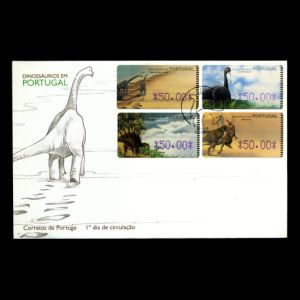 |
 |
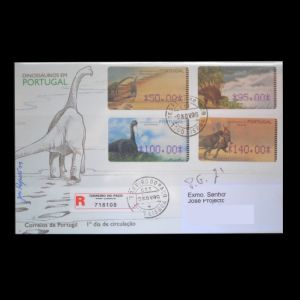 |
| The reverse side is here | Circulated FDC, signed by the artist Jose Projecto | |
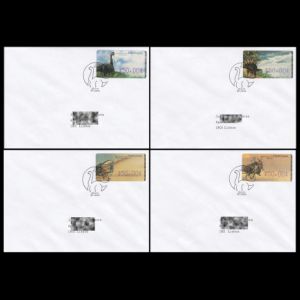 |
 |
 |
| FDC with stamps of SMD machine, with First-Day-of-Issue Postmark of Lisbon (Lisboa) | ||
 |
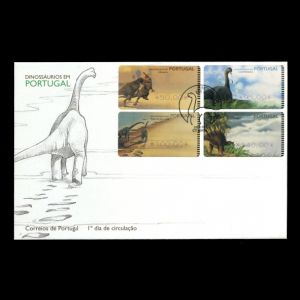 |
 |
| Circulated FDC, signed by the artist Jose Projecto | ||
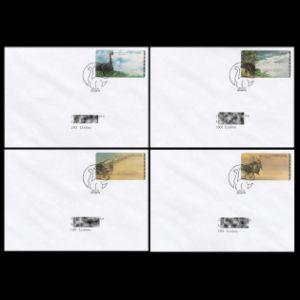 |
 |
 |
| Example of circulated covers | ||
 |
 |
 |
| Registered letter posted in 1999. | Cover with stamp from 1999 sent in 2000. | Cover with Escudo 85 stamp from 1999, posted in 2000. |
| Example of circulated cover | ||
 |
|
|
| Stamps issued in 1999 were supposed to be accepted as postage through 30.09.2001. These covers were mailed in 2004. There are no additional stamps on the reverse sides of these covers. The covers were accepted for mailing even though they were underpaid. The postage rates in 2004 has increased since these were issued in 1999. | ||

|
References
- Technical details and short description:
- colnect
- MICHEL Automatenmarken-Speziel (Vending Machines Special) 2013/2014, 7. Auflage (7th Edition), ISBN: 978-3-95402-951-4
- AFINSA (National Portuguese stamps catalogue) 2009, ISBN: 978-972-9468-15-5
- Stamp designers
- ATM stamps and vending machines of Portugal
- Lourinha: Wikipedia
- Museum of Lourinha: Wikipedia, official website,
- Dinosaurs of Portugal: Lifecooler.com Dinosaur footprints Visit Portugal
Acknowledgments
- Many thanks to fellow stamp collector Mr. Vitor Vieira, who run a blog about ATM stamps of Portugal from Portugal, for his help finding some information about these stamps and for sharing scans of some stamps and covers from his collection.
- Many thanks to fellow stamp collector Mr. Jose Lalanda Jorge from Sintra, Portugal for sharing scans of signed FDC covers from his collection.
- Many thanks to Dr. Peter Voice from Department of Geological and Environmental Sciences, Western Michigan University, for reviewing the draft page and his very valuable comments.
| <prev | back to index | next> |